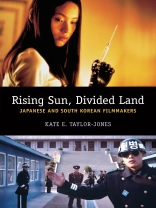Rising Sun and Divided Land provides a comprehensive, scholarly examination of the historical background, films, and careers of selected Korean and Japanese film directors. It examines eight directors: Fukasaku Kinji, Im Kwon-teak, Kawase Naomi, Miike Takashi, Lee Chang-dong, Kitano Takeshi, Park Chan-wook, and Kim Ki-duk and considers their work as reflections of personal visions and as films that engage with globalization, colonialism, nationalism, race, gender, history, and the contemporary state of Japan and South Korea. Each chapter is followed by a short analysis of a selected film, and the volume as a whole includes a cinematic overview of Japan and South Korea and a list of suggestions for further reading and viewing.
Innehållsförteckning
Acknowledgements
Introduction: Rising Sun and Divided Land
Cinematic Japan and Korea: A Long and Turbulent History
Im Kwon-taek and the March of Time
Film Analysis: Chihwaseon
Fukasaku Kinji and Beginning With a Bomb
Film Analysis: Battle Royale
Lee Chang-dong and the Trauma of History
Film Analysis: Secret Sunshine
The Legacy of a Violent Man: Kitano Takeshi
Film Analysis: Hana-bi
Twisted Histories: Park Chan-wook and the Legacy of Personal Trauma
Film Analysis: Oldboy
The Lone Woman: Kawase Naomi
Film Analysis: Shara
Bad Guy: Kim Ki-duk
Film Analysis: Bad Guy
Miike Takashi: Welcome to the Dark Side
Film Analysis: Visitor Q
Conclusion
Bibliography
Filmography and Further Viewing Suggestions
Key Electronic Resources for Japanese and Korean Film
Index
Om författaren
Kate E. Taylor-Jones is lecturer in visual culture at Bangor University, Wales. Her research concerns the visual culture of Japan, South Korea, and gender in visual culture. She has published widely on a variety of topics, including colonial Japanese and Korean cinema, cinema and landscape in East Asia, and domestic violence and the sex trade. She is currently working on an AHRC funded monograph study examining the colonial visual culture of Japan (1938–1945).












